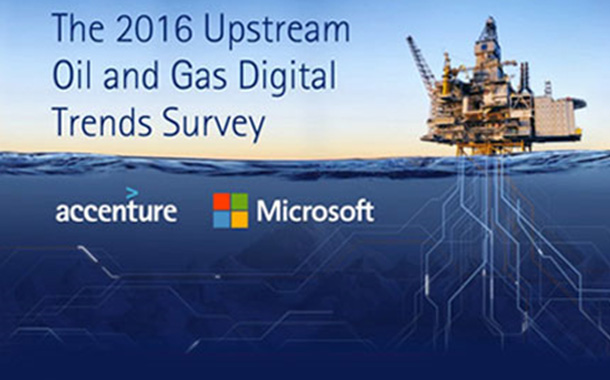Almost two-thirds of upstream firms see the value digital technologies deliver as low oil prices linger, and the top risk of a lack of digital investment is becoming uncompetitive: Research from Accenture and Microsoft Reports
Faster and better decision-making and shorter time to first oil and gas top the list of expected benefits that digital technologies can drive for upstream oil and gas companies, a new survey from Accenture and Microsoft Corp. reports. Respondents to the “Accenture and Microsoft 2017 Upstream Oil and Gas Digital Trends Survey” also estimated the monetary value of digital technologies and noted the next wave’s potential to further transform their business, despite ongoing low oil prices.
Asked to identify the top ways digital benefits their companies, faster and better decision-making (30 percent) remained foremost, as in the 2016edition of the survey. Faster time to produce oil and gas, however, jumped to second place from fifth last year (19 percent). Reduced risk enabled by real-time decision support was the third most important (12 percent).
Now in its sixth edition, the global survey showed the upstream areas most expected to benefit today from digital are production (28 percent), geological and geophysical (27 percent), and drilling and completion (19 percent).
“Digital technologies like IoT and predictive analytics can have a significant impact on the upstream oil and gas companies operations,” said Sandeep Dutta, managing director and lead for Accenture’s resources group in India. “IoT and analytics can help analyze diverse sets of operational data like drilling parameters and cross disciplinary data (geological models) and provide incisive operational insights. Predictive analytics can also reduce downtime, spare parts inventory and boost production in conventional as well as non-operational asset classes. Additionally, by using digital technologies at large, upstream companies can reduce finding, development and maintenance costs; material costs can also be optimized through the right digital interventions.”
Almost two-thirds (62 percent) of the more than 300 professionals surveyed perceive business value from digital technologies, with 27 percent totaling it at$50 million to $100 million or more for their companies. However, 14 percent of upstream respondents don’t know how much monetary value digital is delivering, 20 percent don’t measure it, and 4percent believe digital is adding no value to their businesses today.
Most of the respondents expect their companies to realize value from digital technologies and73 percent said most of their oil and gas fields will become fully automated using these technologies in three to five years.
On the other hand, 39 percent of respondents said the greatest risk from a lack of digital investment is becoming uncompetitive; more than double the next group at 19 percent who cited the inability to transition to a new energy landscape. Surprisingly, despite the rise of connected devices on oilfields further exposing upstream companies to cybersecurity risks, the fear of increased cyberattacks came in at a distant third (18 percent).
“It’s not always about petabytes of data. It’s about a set of solutions and technologies that could not have been achieved even five years ago,” said Egbert Schroeer, Worldwide Managing Director, Process Manufacturing, Microsoft Corp. “Digital is doing more than helping reduce operational costs through increased worker productivity with mobility. The cloud, better asset management and remote monitoring through analytics and artificial intelligence (AI) are driving operational excellence and subsurface data management for the oil and gas industry. However, it will be essential for upstream companies to quickly develop in-house capabilities and add external talent for data analytics and other leading technologies, to stay ahead in the digital revolution.”


